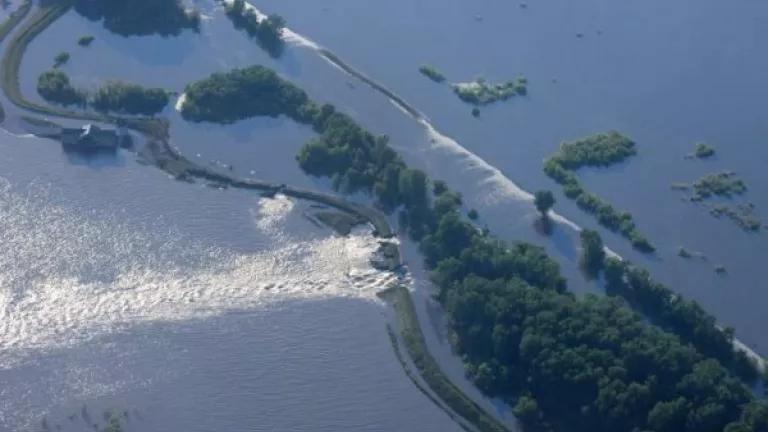Illinois May Kick off Dangerous Game of Levee Construction

The administration of Governor Bruce Rauner wants to reset the clock on floodplain management to a time when the only way to deal with floods was to build levees bigger, higher, taller, and...did I mention bigger?
New rules proposed by Governor Rauner’s Department of Natural Resources (Illinois DNR) would allow levee owners to engage in a dangerous game of one-ups-man-ship, whereby those who raise their levees highest and fastest can do so at the expense of everyone else. If approved, these regulations might usher in a new era of levee construction that would roll back decades of thoughtful floodplain management that has kept Illinois communities safe.
The proposed regulations would severely diminish the state's oversight of levee construction and modifications, allowing levees to be raised with little or no scrutiny from the state. Illinois currently looks closely at how raising a levee might make floods more likely elsewhere. When a levee is raised, it might provide additional protection for the landowners behind it, but it means floodwaters will rise that much higher for the people who live upstream, downstream, and across the river from the newly raised levee.
This unwise move by the Rauner administration would usher in a new "arms race" among levee districts and other flood control projects. Nobody wants to be left with the shortest levee, so when one levee gets raised, everybody else must follow suit, building even higher in the hopes they’ll stay dry and their neighbors will get washed away in the next flood.
Levee districts have been illegally playing this game already. A recent study done by the U.S. Army Corps of Engineers found that 40% of the levees on the Mississippi River north of St. Louis are higher than they are supposed to be. Some were 2 to 4 feet higher than their approved elevation. With Illinois poised to neuter its oversight of levees, this is a pattern of bad behavior that could become even more pervasive.
Another folly of bigger, higher levees is when they fail, the resulting flood is even more destructive. Imagine a 20-foot wall of water rolling through your community. Now imagine a wall of water 30 feet high. Both will do a whole lot of damage, but when a levee that's 30 feet high fails, there will be far more damage over a much larger area.
This “bigger is better” approach fails to recognize the wisdom in an old joke: “There are two kinds of levees. Those that have failed and those that will fail.”
The Rauner administration's proposed rules take Illinois backwards several decades in the history of floodplain management, to a time when levees and floodwalls were seen as the only solution to flooding. Now we know better. Moving levees back and giving the river room to spread out is less dangerous. Restoring wetlands and bottomland forests help absorb smaller floods. And keeping development out of flood prone areas is the safest strategy of all.
Illinois has long been recognized for its thoughtful regulation of levee construction. It has allowed levees to be built, but only after consideration of how flood risks elsewhere may be exacerbated and taking steps to make sure one area’s gain does not come at the price of another’s misfortune. It's not in the state's best interests to see flood heights go higher, which is what happens when levees go higher.
NRDC filed comments that were very critical of the state's regressive proposal. We can only hope that the floodplain management professionals at the IDNR reconsider the proposed rules and don’t allow the state to be swept up in a new arms race of building bigger and bigger levees on the state's rivers.

